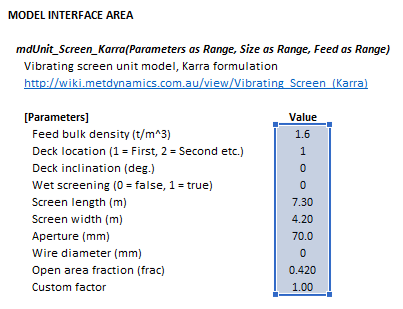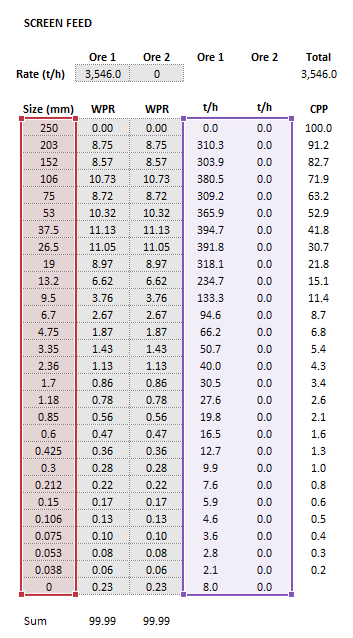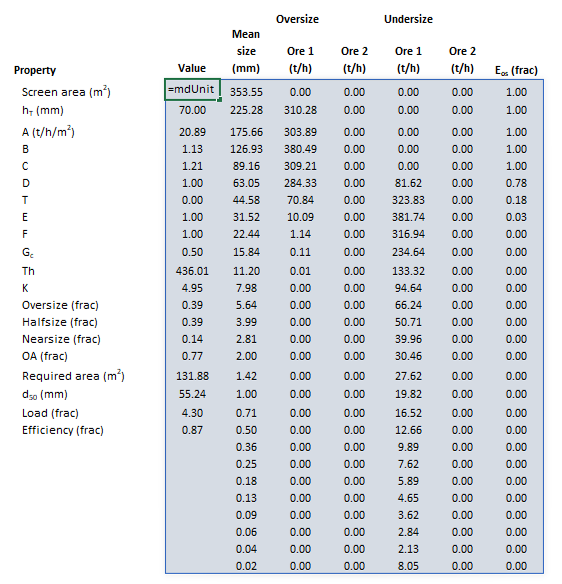Vibrating Screen (Karra)
Description
This article describes the Karra model for vibrating screen classification.[1]
Model theory
Capacity
Basic capacity (A)
Oversize factor (B)
Half-size factor (C)
Deck location factor (D)
Wet screening factor (E)
Bulk density factor (F)
Near-size capacity factor (Gc)
Classification
Load and efficiency
Excel
The Karra screen model may be invoked from the Excel formula bar with the following function call:
=mdUnit_Screen_Karra(Parameters as Range, Size as Range, Feed as Range)
Invoking the function with no arguments will print Help text associated with the model, including a link to this page.
Inputs
The required inputs are defined below in matrix notation with elements corresponding to cells in Excel row () x column () format:
where:
- indicates whether the wet screening factor, , should be applied (True/False)
- is the length of the screening surface in the direction of flow (m)
- is the width of the screening surface transverse to the direction of flow (m)
- is the size of the square mesh interval that feed mass is retained on (mm)
- is the number of ore types
- is feed solids mass flow rate by size and ore type (t/h)
Results
The results are displayed in Excel as an array corresponding to the matrix notation below:
where:
- is mass flow rate of solids to the oversize stream (t/h)
- is mass flow rate of solids to the undersize stream (t/h)
- is partition fraction of feed solids to the oversize stream (frac)
Example
The images below show the selection of input arrays and output results in the Excel interface.
SysCAD
The sections and variable names used in the SysCAD interface are described in detail in the following tables.
Note that both a Deck page and a Partition page are provided for each connected oversize discharge stream.
MD_Screen page
The first tab page in the access window will have this name.
| Tag (Long/Short) | Input / Display | Description/Calculated Variables/Options |
|---|---|---|
| Tag | Display | This name tag may be modified with the change tag option. |
| Condition | Display | OK if no errors/warnings, otherwise lists errors/warnings. |
| ConditionCount | Display | The current number of errors/warnings. If condition is OK, returns 0. |
| GeneralDescription / GenDesc | Display | This is an automatically generated description for the unit. If the user has entered text in the 'EqpDesc' field on the Info tab (see below), this will be displayed here.
If this field is blank, then SysCAD will display the unit class ID. |
| Requirements | ||
| On | CheckBox | This enables the unit. If this box is not checked, then the MassFracToOS option appears below. |
| MassFracToOS | Input | Only appears if the On field above is not checked. Specifies the fraction of feed mass that reports to the overflow stream when the model is off. |
| NumParallelUnits | Input | The number of parallel, identical units to simulate:
|
| Options | ||
| ShowQFeed | CheckBox | QFeed and associated tab pages (eg Sp) will become visible, showing the properties of the combined feed stream. |
| SizeForPassingFracCalc | Input | Size fraction for % Passing calculation. The size fraction input here will be shown in the Stream Summary section. |
| FracForPassingSizeCalc | Input | Fraction passing for Size calculation. The fraction input here will be shown in the Stream Summary section. |
| Stream Summary | ||
| MassFlow / Qm | Display | The total mass flow in each stream. |
| SolidMassFlow / SQm | Display | The Solids mass flow in each stream. |
| LiquidMassFlow / LQm | Display | The Liquid mass flow in each stream. |
| VolFlow / Qv | Display | The total Volume flow in each stream. |
| Temperature / T | Display | The Temperature of each stream. |
| Density / Rho | Display | The Density of each stream. |
| SolidFrac / Sf | Display | The Solid Fraction in each stream. |
| LiquidFrac / Lf | Display | The Liquid Fraction in each stream. |
| Passing | Display | The mass fraction passing the user-specified size (in the field SizeForPassingFracCalc) in each stream. |
| Passes | Display | The user-specified (in the field FracForPassesSizeCalc) fraction of material in each stream will pass this size fraction. |
Deck page
The Deck page is used to specify the required model method and associated input parameters.
| Tag (Long/Short) | Input / Display | Description/Calculated Variables/Options |
|---|---|---|
| Deck | ||
| On | Checkbox | This enables the deck. If off, the feed to this deck passes directly to the next deck (or undersize) without partition. |
| Method | Partition (User) | The partition to oversize for each size interval is defined by the user. Different values can be used for different solids. |
| Partition (Reid-Plitt) | The partition to oversize for each size interval is defined by a Reid-Plitt efficiency curve. Different parameters can be used for different solids. | |
| Partition (Whiten-Beta) | The partition to oversize for each size interval is defined by a Whiten-Beta efficiency curve. Different parameters can be used for different solids. | |
| Vibrating (Karra) | The Karra vibrating screen model is used to determine the partition of solids to oversize and undersize for each size interval. | |
| Vibrating (Whiten) | The Whiten vibrating screen model is used to determine the partition of solids to oversize and undersize for each size interval. | |
| Vibrating (Metso) | The Metso vibrating screen model is used to determine the partition of solids to oversize and undersize for each size interval. | |
| Fine Wet (Mwale) | The Mwale fine wet screen model is used to determine the partition of solids to oversize and undersize for each size interval. | |
| Dewatering (Ng) | The Ng dewatering screen model is used to determine the moisture content of oversize material, and the partition of solids to oversize and undersize for each size interval. | |
| HelpLink | Opens a link to this page using the system default web browser. Note: Internet access is required. | |
| Parameters | ||
| FeedBulkDensity / RhoBulk | Input | The bulk density of the feed solids. |
| DeckLocation / S | Input | Deck location, 1 = First, 2 = Second etc. |
| DeckInclination / Theta | Input | Angle of inclination of the deck. |
| WetScreening | Input | Indicates if the deck is wet screening (sprays, slurry etc). |
| ScreenLength | Input | Length of the screen. |
| ScreenWidth | Input | Width of the screen. |
| Aperture / h | Input | Size of the apertures in the deck. |
| WireDiameter / dw | Input | Diameter of the wire in the woven mesh screening surface (or distance between apertures). |
| OpenAreaFraction / ActualOA | Input | Open area fraction of the deck. |
| CustomFactor | Input | User defined factor for adjusting the theoretical screen capacity. |
| Liquids | ||
| LiquidsSeparMethod | Split To OS (User) | Liquids are split to oversize by a user-defined fraction of liquids in the feed. |
| OS Solids Fraction | Sufficient liquids mass is recovered to the oversize stream to yield the user-defined oversize solids mass fraction value (if possible). | |
| OS Liquids Fraction | Sufficient liquids mass is recovered to the oversize stream to yield the user-defined oversize liquids mass fraction value (if possible). | |
| OSSolidsFracReqd / OS.SfReqd | Input | Required value of the mass fraction of solids in the oversize stream. Only visible if OS Solids Fraction is selected. |
| OSLiquidsFracReqd / OS.LfReqd | Input | Required value of the mass fraction of liquids in the oversize stream. Only visible if OS Liquids Fraction is selected. |
| LiqSplitToOS / OS.LiqSplit | Input/Display | The fraction of feed liquids recovered to the oversize stream. |
| Results | ||
| ScreenArea | Display | Area of the deck. |
| ThroughfallAperture/ hT | Display | Effective aperture size experienced by particles falling under gravity. |
| BasicCapacity / A | Display | Basic capacity of the screen. |
| OversizeFactor / B | Display | Particle oversize screen capacity factor. |
| HalfsizeFactor / C | Display | Particle halfsize screen capacity factor. |
| OversizeFactor / B | Display | Oversize screen capacity factor. |
| DeckLocationFactor / D | Display | Deck location screen capacity factor. |
| WetScreeningFactorT / T | Display | Wet screening screen capacity factor calculation parameter. |
| WetScreeningFactor / E | Display | Wet screening screen capacity factor. |
| NearSizeFactor / Gc | Display | Particle near-size screen capacity factor. |
| TheoreticalUndersize / Th | Display | Theoretical undersize transmission rate of the deck. |
| LoadingCoefficient / K | Display | Ratio of flow rate of sub aperture material in the feed to the theoretical screen capacity. |
| Halfsize | Display | Fraction of feed smaller than half the throughfall aperture. |
| Nearsize | Display | Fraction of feed near the throughfall aperture size. |
| Oversize | Display | Fraction of feed larger than the throughfall aperture. |
| OpenAreaWire / OA | Display | Estimated open area fraction of woven wire mesh. |
| RequiredArea | Display | Screening area required to treat feed stream at 100% loading. |
| d50 | Display | Size at which the 50% of the feed particle mass is partitioned to oversize. |
| Load | Display | Ratio of mass flow of actual undersize to theoretical transmission rate to undersize of screen. |
| Efficiency | Display | Fraction of total sub-aperture sized material in feed that is actually recovered to the undersize stream. |
Partition page
The Partition page is used to display (or specify) the partition by species/component/element/individual phase and size values.
| Tag (Long/Short) | Input / Display | Description/Calculated Variables/Options |
|---|---|---|
| Distribution | ||
| Name | Display | Shows the name of the SysCAD Size Distribution (PSD) quality associated with the feed stream. |
| IntervalCount | Display | Shows the number of size intervals in the SysCAD Size Distribution (PSD) quality associated with the feed stream. |
| SpWithPSDCount | Display | Shows the number of species in the feed stream assigned with the SysCAD Size Distribution (PSD) quality. |
| Partition | ||
| Method | Model / User | Select model-calculated or user-defined partition to separate each solids species type. |
| Density | Display | Density of each solid species. |
| Size | Display | Size of each interval in mesh series. |
| MeanSize | Display | Geometric mean size of each interval in mesh series.
|
| All (All column) | Display |
|
| Partition | Display |
|
| All (All row, All column) | Display |
|
| All (All row, per species) | Display |
|
| CmpPartition | ||
| Components | Hides or shows component partition table. | |
| Size | Display | Size of each interval in mesh series. |
| MeanSize | Display | Geometric mean size of each interval in mesh series. |
| All (All column) | Display |
|
| CmpPartition | Display |
|
| All (All row, All column) | Display |
|
| All (All row, per component) | Display |
|
| ElePartition | ||
| Elements | Hides or shows element partition table. | |
| Size | Display | Size of each interval in mesh series. |
| MeanSize | Display | Geometric mean size of each interval in mesh series. |
| All (All column) | Display |
|
| ElePartition | Display |
|
| All (All row, All column) | Display |
|
| All (All row, per element) | Display |
|
| IPhPartition | ||
| IPhases | Hides or shows individual phases partition table. | |
| Size | Display | Size of each interval in mesh series. |
| MeanSize | Display | Geometric mean size of each interval in mesh series. |
| All (All column) | Display |
|
| IPhPartition | Display |
|
| All (All row, All column) | Display |
|
| All (All row, per individual phase) | Display |
|
About page
This page is provides product and licensing information about the Met Dynamics Models SysCAD Add-On.
| Tag (Long/Short) | Input / Display | Description/Calculated Variables/Options |
|---|---|---|
| About | ||
| HelpLink | Opens a link to the Installation and Licensing page using the system default web browser. Note: Internet access is required. | |
| Information | Copies Product and License information to the Windows clipboard. | |
| Product | ||
| Name | Display | Met Dynamics software product name |
| Version | Display | Met Dynamics software product version number. |
| BuildDate | Display | Build date and time of the Met Dynamics Models SysCAD Add-On. |
| License | ||
| File | This is used to locate a Met Dynamics software license file. | |
| Location | Display | Type of Met Dynamics software license or file name and path of license file. |
| SiteCode | Display | Unique machine identifier for license authorisation. |
| ReqdAuth | Display | Authorisation level required, MD-SysCAD Full or MD-SysCAD Runtime. |
| Status | Display | License status, LICENSE_OK indicates a valid license, other messages report licensing errors. |
| IssuedTo | Display | Only visible if Met Dynamics license file is used. Name of organisation/seat the license is authorised to. |
| ExpiryDate | Display | Only visible if Met Dynamics license file is used. License expiry date. |
| DaysLeft | Display | Only visible if Met Dynamics license file is used. Days left before the license expires. |
Additional notes
- Solid species that do not possess a particle size distribution property are split according to the overall mass split of the default particle size distribution species selected in the SysCAD Project Configuration.
- If the default particle size distribution species is not present in the unit feed, the overall split of all other species with particle size distributions combined is used, as determined by the model.
- Gas phase species report directly to the undersize stream without split.
See also
External links
References
- ↑ Karra, V.K., 1979. Development of a model for predicting the screening performance of a vibrating screen. CIM Bull.;(United States), 72(804).
















